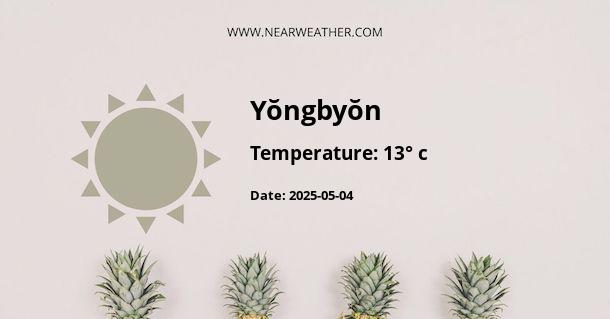Weather
0° 
Climate Conditions: clear sky
Humidity: 46%
Wind speed: 11.63 km/h
Wind direction: 355°
Daily Weather Forecast
Friday
11/22/2024
Climate Conditions: clear sky
Humidity: 49%
Saturday
11/23/2024
Climate Conditions: clear sky
Humidity: 50%
Sunday
11/24/2024
Climate Conditions: clear sky
Humidity: 49%
Monday
11/25/2024
Climate Conditions: overcast clouds
Humidity: 51%
Tuesday
11/26/2024
Climate Conditions: overcast clouds
Humidity: 91%
Evolution
Daily Weather Forecast Evolution (°C)
Lowest temperature
Highest temperature
Other Information
Sunrise
07:29
Sunset
17:16
Latitude
39.813332
Longitude
125.804169
Timezone: GMT+05:30
More about Yŏngbyŏn:
Climate and Weather in Yongbyon, North Korea
Yongbyon is a city located in North Korea, known for its historical significance and its role in the country's nuclear program. Understanding the climate and weather patterns in Yongbyon is essential for residents, tourists, and researchers alike. In this article, we will explore the climate and weather conditions in Yongbyon throughout the year.Geographical Location and Influence
Yongbyon is situated in the central part of North Korea, on the banks of the Kuryong River. Its geographical location plays a significant role in shaping its climate and weather patterns. The city lies in a temperate climate zone, with distinct seasonal variations.Seasonal Overview
1. Spring (March to May): Spring in Yongbyon is characterized by mild temperatures and the blooming of flowers and trees. March is still chilly, with temperatures ranging from 0°C (32°F) to 9°C (48°F). By May, the temperatures rise to an average of 11°C (52°F) to 20°C (68°F), and the city becomes vibrant with lush greenery. 2. Summer (June to August): Summers in Yongbyon are warm and humid. June marks the beginning of the rainy season, with occasional thunderstorms. Average temperatures range from 21°C (70°F) to 26°C (79°F). July and August are the hottest months, with temperatures reaching up to 30°C (86°F). It is advisable to carry umbrellas or raincoats during this season due to frequent showers. 3. Autumn (September to November): Autumn in Yongbyon is characterized by pleasant temperatures and beautiful fall foliage. September still retains some warmth from summer, with temperatures ranging from 19°C (66°F) to 26°C (79°F). As the season progresses, temperatures gradually drop to 6°C (43°F) to 14°C (57°F) in November. 4. Winter (December to February): Winters in Yongbyon are cold and dry, with occasional snowfall. December and January are the coldest months, with temperatures ranging from -10°C (14°F) to -2°C (28°F). February brings some relief, with temperatures increasing slightly to -6°C (21°F) to 3°C (37°F). It is essential to bundle up and wear appropriate winter clothing to stay warm during this season.Precipitation and Humidity
Yongbyon experiences a moderate amount of rainfall throughout the year, with the highest precipitation occurring during the summer months. The average annual rainfall in Yongbyon is around 1200 mm. July and August are the wettest months, with an average rainfall of 300 mm. During this time, humidity levels can rise, making it feel warmer than the actual temperature.Wind Patterns
Yongbyon is influenced by prevailing winds from the northwest, which bring cold air during the winter months. These winds contribute to the lower temperatures and occasional snowfall during the winter season. In the summer, winds from the southeast can bring in warm and moist air, leading to increased humidity and precipitation.Extreme Weather Events
Although Yongbyon does not experience extreme weather events on a regular basis, it is important to note that North Korea, as a whole, is prone to typhoons during the summer and early autumn. These tropical cyclones can bring heavy rainfall, strong winds, and potential flooding to the region. It is advisable to stay updated with local weather forecasts and follow any evacuation recommendations during such events.Climate Data for Yongbyon
To provide a more comprehensive understanding of the climate in Yongbyon, here is a table showcasing average monthly temperatures and rainfall:| Month | Average Temperature (°C) | Average Rainfall (mm) |
|---|---|---|
| January | -6 to 3 | 8 |
| February | -6 to 3 | 10 |
| March | 0 to 9 | 20 |
| April | 6 to 15 | 50 |
| May | 11 to 20 | 80 |
| June | 16 to 24 | 180 |
| July | 21 to 26 | 300 |
| August | 21 to 26 | 300 |
| September | 16 to 23 | 150 |
| October | 9 to 16 | 60 |
| November | 1 to 10 | 30 |
| December | -2 to 4 | 10 |
Conclusion
Yongbyon experiences a temperate climate with distinct seasons. Spring and autumn offer mild temperatures, while summers can be hot and humid. Winters are cold with occasional snowfall. Understanding the climate and weather patterns in Yongbyon is crucial for planning outdoor activities and ensuring appropriate clothing and preparations. Stay informed about local weather forecasts and any potential extreme weather events to make the most of your time in Yongbyon.FAQ's about Yŏngbyŏn's Weather:
Q - What is the Latitude and Longitude of Yŏngbyŏn?
A - Yŏngbyŏn's Latitude is 39.813332 & Longitude is 125.804169.
Q - What is the weather in Yŏngbyŏn today?
A - Weather in Yŏngbyŏn is 0° today.
Q - What is the climatic condition of Yŏngbyŏn today?
A - Climate Conditions in Yŏngbyŏn shows clear sky today.
Q - What is the humidity in Yŏngbyŏn today?
A - Humidity in Yŏngbyŏn is 46% today.
Q - What is the wind speed in Yŏngbyŏn today?
A - Wind speed in Yŏngbyŏn is 11.63 km/h, flowing at 355° wind direction. today.

Nearby Locations
Latest searched locations